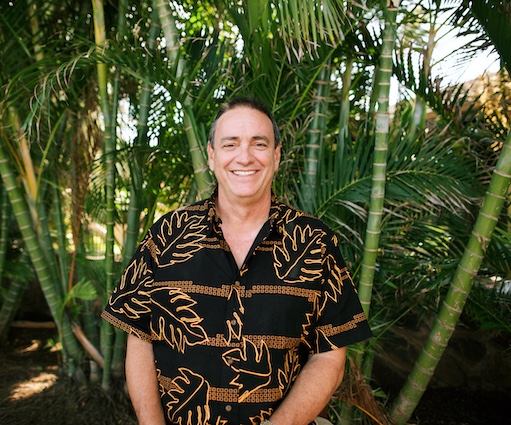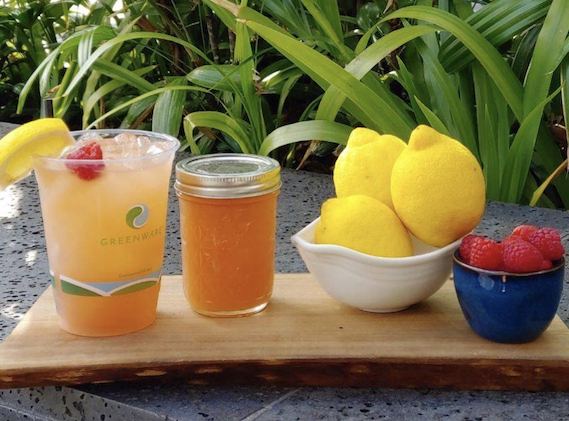Chef Peter Merriman, founder/owner of Merriman’s Restaurants, has been serving up Hawaii regional cuisine throughout the state for nearly 33 years. What started as a fine-dining concept in Waimea on the Big Island now also includes Merriman’s Honolulu (Oahu), Merriman’s Kapalua (Maui) and Merriman’s Fish House on Kauai.
Like many on-premise operators, Merriman was forced to temporarily close his restaurants in March 2020 due to the pandemic, which meant furloughing nearly 1,200 employees across the four islands. Merriman’s began slowly reopening restaurants in July, starting with a burger and beer garden on the outdoor terrace of Honolulu location. All locations are back up and running with indoor dining as of March 2021.
How has business changed in the past year? The restaurants follow all government guidelines regarding mask wearing, regular sanitization of high touch points, limiting party sizes, conducting daily employee health checks, offering hand sanitizer and keeping tables six feet apart, Merriman says. “We’re also taking the additional step of adding portable HEPA air filters in some of our kitchens to keep our staff as safe as possible.”

And while the menus are smaller now than they were pre-shutdown, “we’re still committed to serving local products,” he adds.
What exactly is Hawaii regional cuisine? Merriman’s specialties include ahi ginger poke with homemade Molokai sweet potato chips and macadamia-nut-crusted kona kompachi, along with heartier fare such as the kalua pig and sweet onion quesadillas and the Waipio taro enchiladas. “We’ve had raging success with our kalo (taro) enchiladas, which were the staple crop of the indigenous Hawaiian people,” Merriman says.
The same thinking applies to the beverage program as well: Keep it simple, and incorporate local produce and flavors. The current menu lists just seven drinks, “and 90% of bar sales come from those drinks,” master mixologist Jim Lunchick.
Distinctive terroir and taste
Merriman’s looks for ways to incorporate local and fresh ingredients that bring its distinctive terroir and taste to light, says Lunchick. “Every day our beverage team goes into our organic garden at Merriman’s Waimea and picks garnishes and ingredients for that nights’ cocktail program,” he says. “It’s true farm-to-table, and in this case it’s farm-to-bar!”
For instance, Merriman’s Waimea uses fresh red shiso, along with green coriander seeds, Mexican mint marigold (a tarragon-like herb) and ginger, to infuse Punt e Mes vermouth for its Manhattans.
The company has also been growing roselle, a type of hibiscus, to incorporate into the cocktail program, Lunchick says. “We’ve started drying the pods and leaves to incorporate into drinks when spring comes.”

But in general, “we don’t want to go nuts with a lot of ingredients,” Lunchick says. “We take the classics and put a local spin on them.” The restaurant’s most-popular drink is a Mai Tai featuring a lilikoi—better known as passion fruit—foam. Merriman’s has sold more than 1 million of them.
Lunchick has also been playing around with calamansi, a citrus fruit that’s a cross between a mandarin and kumquat and is abundant in Hawaii. Merriman’s is putting its own twist on the Old Fashioned and using calamansi in place of orange.
“We boil the calamansi in sugared water and take the peels, coat them in syrup, and brulée them to make an edible garnish on the drink,” Lunchick says. “It’s beautiful and tastes like candy.”
An expat with local vision
A native of Pittsburgh, Merriman arrived in Hawaii in 1983 to cook at the Mauna Lani Bay Hotel on the Big Island. He opened his first restaurant in Waimea in 1988.
Merriman’s restaurant showcased island-grown and harvested foods through simple preparations that reflect the flavors of Hawaii’s multiculturalism, which was a novel idea 30 years ago. The concept made Merriman one of the original pioneers of Hawaii regional cuisine.
Merriman added two more fine-dining restaurants to the Merriman’s Hawaii group in 2008 and 2009: Merriman’s Kapalua, on the grounds of the Kapalua Maui resort, and Merriman’s Fish House in Poipu, Kauai, which downstairs operates Merriman’s Gourmet Pizza & Burgers. Merriman’s Honolulu opened in 2018.

A casual dining venture with restaurateur Bill Terry called Monkeypod Kitchen by Merriman launched in Wailea, Maui, in 2011, followed by locations in the Ko Olina Resort on Oahu in 2013 and on Ka’anapali Beach in the Whaler’s Village Shopping Center on Maui in 2017. The restaurant features locally sourced menus with a focus on sustainable meat, fish and produce as well as regional craft beer and culinary cocktails.
Merriman and Terry plan to grow the chain over the next few years. A new location of Monkeypod Kitchen is scheduled to open at the end of this year as the signature beachfront restaurant at the Outrigger Reef Waikiki Beach Resort.
How has Hawaii’s food and beverage industry changed in the past few decades? “Our clientele has become much more demanding and the response has been to offer higher quality food and beverage,” Merriman says, particularly through the sourcing of ingredients. “It’s so much more than just the locally caught fish.”
Trending beverages
In terms of adult beverages, Hawaii has evolve in the past few decade similar to the mainland, but often at a different pace, says Lunchick. “For instance, the explosion of demand for rosé wines reached Hawaii a good six or seven years after taking hold on the mainland—despite the fact that our climate is so ideally suited for their enjoyment.”
The plethora of farm-to-table restaurants in Hawaii has helped develop wine lists that do justice to the cuisine, Lunchick says. “The somm culture here is very tightknit, and we all inspire each other to find and highlight wines that are appropriate to the cutting-edge food scene that has grown here,” he explains.

Is it hard to get wines to Hawaii? Not at all, Lunchick says: “We can get everything we want.” That’s because everyone wants to come to Hawaii to show their wines and get them on lists—and take a vacation as well, he notes.
What’s more, Lunchick adds, “we can show a lot of unusual wines.” He often includes those wines in flights of four 3-oz. pours that he pairs with fresh local cuisine. The flights help drive sales of glasses and bottles of wine, Lunchick says.
Merriman’s has been seeing an increase in lighter, more summery wines, he says. For beers, tropical fruit ciders from local businesses like Ola Brew are big right now. Ola brews seltzers and ciders with fruits, spices and herbs such as pineapple, ginger and lemongrass.

On the cocktail side, Lunchick says, “we’re seeing a reinterest in old Tiki cocktails that had been previously forgotten but are coming back revamped.” Mixologists are using fresher ingredients and elevated glassware to present reimagined Tiki cocktails.
“Glassware is a huge thing: Presentation is half of what goes into craft cocktails,” Lunchick says.
The aforementioned Mai Tai is made with rum, Tahitian lime juice, macadamia-nut orgeat and orange flower water—both house-made. The passion fruit-honey foam is piped on top like a whipped cream swirl. But it’s not a sweet drink, he says; the sweetness comes from the foam.
Covid shifts and strategies
When the pandemic forced Peter Merriman to close his restaurants and furlough employees last spring, he sprang into action to help the community. He partnered with his local farmers and purveyors to buy food and redistributed more than 20,000 pounds of fresh food to employees at all four locations until early July.
He and his team also set up a GoFundMe campaign and distributed grants to over 25 employees in need.
While his restaurants had been known for fine dining, Merriman pivoted with the Covid climate and during the summer reopened all his locations for an outdoor barbeque dining experience. Starting with the Merriman’s Honolulu location, the company launched a street burger and beer garden on its outdoor terrace, and then carried the concept to its other locations on Waimea, Maui and Kauai.

All locations offered a set menu along with daily, seasonal Hawaii regional cuisine specials.
When they reopened Merriman’s Waimea for indoor dining on Aug. 4, “we immediately started offering cocktails and wine to-go,” Lunchick says. “We discounted the wine to-go by 25% for the first two months and it was a hit!”
The wine list includes bottles that range from $54 a bottle to higher price points of $389 and up.
The rules were constantly changing with cocktails to-go, however. For instance, to be able to offer them as of this past winter, the drinks had to be sealed with shrink-wrap. That would mean the bartenders would have to blow dry the plastic on top after making the drink, so Lunchick felt it wasn’t worth the effort.
But Merriman’s is doing large-format cocktails that can be prepared and packaged in advance. Priced at $50, the jars hold about four drinks and are designed to go with the monthly themed Chef’s Table at Home meal kits that Merriman’s began offering in January. The meal kits are influenced by the chef’s upbringing, world travels and memorable moments.
The pandemic put a pause on a few aspects of the beverage program. For instance, Lunchick says he’s not offering the wine flights at the moment, to avoid too much contact at the table and additional glasses to clear.

He also took out draft beers for the time being, but plans to bring them back when volume justifies it.
That may be sooner rather than later. Since the restaurants reopened for indoor dining, “demand has been unbelievable,” Lunchick says. With just half the tables available due to capacity restrictions, “we turned away 800 people for Valentine’s Day!”
In addition to the dining rooms, Merriman’s will continue to offer outdoor dining to be able to incorporate more guests. “We’re in the business of hospitality,” Merriman notes. “Our mantra is to ‘Throw a party every night!’ and that hasn’t changed. We’re just throwing a socially distant party every night now.”









